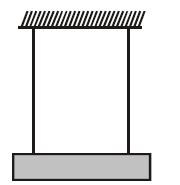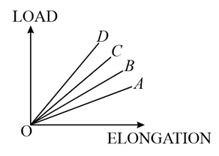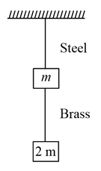EASY
NEET
IMPORTANT
Earn 100
Two wires of equal length and cross-section area suspended as shown in the figure. Their Young's modulus are and respectively. The equivalent Young's modulus will be


(a)
(b)
(c)
(d)
50% studentsanswered this correctly

Important Questions on Elasticity
EASY
NEET
IMPORTANT
The load versus elongation graph for four wires of the same materials is shown in the figure. The thinnest wire is represented by the line:

EASY
NEET
IMPORTANT
HARD
NEET
IMPORTANT
EASY
NEET
IMPORTANT
MEDIUM
NEET
IMPORTANT
HARD
NEET
IMPORTANT
EASY
NEET
IMPORTANT
EASY
NEET
IMPORTANT
If the ratio of lengths, radii and Young’s moduli of steel and brass wires in the figure are and respectively. Then the corresponding ratio of increase in their lengths would be:

